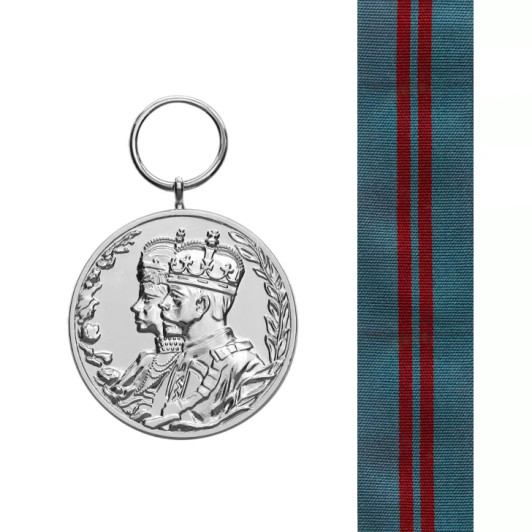
The King Edward VII Coronation Medal was issued in 1902 to commemorate the coronation of King Edward VII and Queen Alexandra, which took place on 9 August 1902. Originally planned for 26 June 1902, the ceremony was postponed due to the King’s illness. The medal was presented to members of the Royal Family, dignitaries, military personnel, and officials who participated in the coronation celebrations.
Awarded in gold, silver, and bronze versions to distinguished guests, senior military officers, and selected participants in the coronation parade and ceremonies. The silver medal was typically presented to officers and officials, while the bronze version was often awarded to non-commissioned officers, other ranks, and civic personnel involved in the event.
The circular medal features conjoined crowned busts of King Edward VII and Queen Alexandra facing left on the obverse. The reverse bears the royal cypher surmounted by a crown, flanked by the date of the coronation, and surrounded by a decorative wreath.
The ribbon is dark blue with a narrow central red stripe, reflecting the colours of the United Kingdom and symbolising loyalty and royal service.
SPECIFICATIONS:If you order your King Edward VII Coronation Medal unmounted, the medal and ribbon will be supplied as separate components. Miniature medals will be supplied with 15cm of ribbon and full size medals will be supplied with 30cm of ribbon.
The court mounting of medals involves securing medals to a stiff backing board, along with the placement of a brooch fitting on the board. This ensures that the medals remain firmly in place and do not shift or move about while being worn.
It is mandatory for active members of the Australian Defence Force to have their medals court mounted, as it is considered the appropriate method of presenting military honours in a professional and respectful manner. By doing so, the medals are given proper recognition and are displayed in a neat and organized fashion.The swing mounting of medals refers to the attachment of a medal to a ribbon that is allowed to hang freely from a brooch, which in turn is affixed to a uniform or clothing. This mounting style was commonly used for medals from the Boer War up to and including World War II, although there are no fixed guidelines or regulations regarding its use.
Miniature Court Mounted medals are mounted using the same method as Full size medals, yet they are typically worn to ceremonies were wearing full size medals would be impractical. These medals are commonly worn to all ceremonies that take place after 6 pm such as dinners.
Miniature Swing Mounted medals are mounted using the same method as Full size medals, yet they are typically worn to ceremonies were wearing full size medals would be impractical. These medals are commonly worn to all ceremonies that take place after 6 pm such as dinners.
A ribbon bar is a small, rectangular display of ribbons worn on military uniforms to represent various honours and awards earned by the wearer. These ribbons are arranged in a specific order and are attached to a backing, which is then attached to the uniform. Ribbon bars are a compact and convenient way for military personnel to display their achievements and are often used in situations where a full-sized medal or award would be impractical.
MagnaRack® is a revolutionary magnetic system designed to make medal and ribbon mounting easier, faster, and more secure. Whether you're in the military, a veteran, part of an emergency service, or proudly wearing a loved one's medals, MagnaRack eliminates the hassle of traditional pins that damage uniforms. The system is incredibly easy to use, perfect for those with limited dexterity, and ideal for elderly users who find small pins difficult to handle.
This style uses a rigid board with the medals secured in position, combined with a magnetic strip for fastening to clothing. The magnets hold the medals in place without the need for pins, preventing fabric damage. Court mounting keeps the medals aligned and presented in a professional layout. The magnetic version provides the same appearance with the added benefit of easy on and off.
Swing mounting allows the medal to hang freely from its ribbon. In the magnetic style, the top bar contains magnets instead of a pin or brooch, attaching securely to your jacket or shirt. This gives the traditional swinging style without putting holes in fabric and allows quick attachment and removal.
Miniature court mounting is arranged on a firm backing like the full size version but in smaller scale for formal evening wear. The magnetic fitting replaces pins, protecting clothing and making it faster to put on or take off. These are often worn at dinners and functions.
Miniature swing mounting allows the medals to move freely from the ribbon, with magnets in the top bar for fastening. This avoids damage to uniforms and is convenient for events where full size medals are not required.
A ribbon bar is a compact way to wear medal ribbons in the correct order of precedence. The magnetic back lets the bar attach to your uniform without pins, keeping the fabric intact. This is a practical choice for daily wear when full medals are not needed.